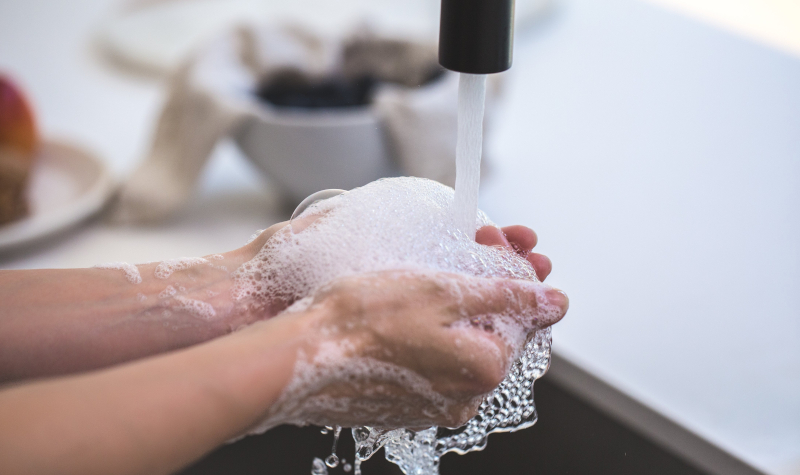Food contamination, sanitation and employee hygiene should be an ongoing priority for businesses that serve food and beverages to prevent the dissemination of disease-causing germs.
With the U.S. government recommending Americans avoid eating and drinking in bars, restaurants or food courts to prevent the COVID-19 illness from spreading—and several states issuing directives that eliminate dine-in service—a number of operators are focusing on takeout and delivery services.
Recent research, though, indicates some customers may be hesitant to place orders. Nearly 60 percent of U.S. consumers are concerned about eating out due to COVID-19. Eighty-nine percent say they feel safer eating food from grocery stores or home.
To alleviate customers’ fears, a number of operators have recently shared information about their cleaning and sanitizing procedures and some of the changes they’ve made to enhance safety. These include:
Cleaning and Disinfecting Surfaces
The CDC recommends routinely cleaning high-touch surfaces such as doorknobs, countertops, and sinks with soap and water. They can then be disinfected with a diluted household bleach solution (if it’s appropriate for the surface), a solution containing at least 70 percent alcohol or an EPA-registered household disinfectant. Keep the surface wet for several minutes to ensure germs are killed.
In addition to regularly wiping down PIN pads, door handles and other surfaces, fast food chain Tim Hortons has increased the frequency of its cleaning and sanitizing efforts in recent weeks. Fast-casual chain Qdoba Mexican Eats announced in mid-March that it, too, was increasing how often daily cleaning and disinfecting procedures occurred. A few days later, the company went a step further and removed shared condiments from its restaurants.
Meanwhile, Pieology Pizzeria, a fast-casual create-your-own-pizza chain with more than 120 locations in 19 states and Guam, has implemented mandatory cleanings every hour.
Disposable gloves offer additional protection for employees when cleaning—and can also help decrease transmission risk during the food preparation process. An FDA norovirus study found employees wearing gloves reduced the mean number of customer infections by 62 percent.
The transparency and frequency of sanitation enhancements is important for all operators. These protocols should be clearly communicated to build consumer trust.
Limiting Interactions
A number of states, including Illinois, Maryland and New Jersey, have issued operational directives preventing restaurants from serving customers in their establishment. To encourage people to order food to be delivered, some, like Chipotle and Dickey’s Barbecue Pit, have eliminated their delivery fee.
Restaurants are also offering touchless (or “contactless”) delivery. Little Caesars’ drivers, for example, will leave an order at your door upon request. Patrons can also pick up a pizza without coming into contact with another person by placing a mobile order and scanning their phone at a portal inside the Little Caesars location, where their order will be waiting in a heated compartment. Pieology’s restaurants are still open for guests to place and pick up carryout orders. But the company will only allow a maximum of 10 people inside at a time and has marked floors with tape to encourage safe distancing-oriented spacing. Staff members will also bring carryout orders to guests’ cars, upon request.
Sending Sick Employees Home
The FDA’s study also found that if an ill employee is working at a food establishment, the typical prevention strategies won’t effectively keep a norovirus from being transmitted to foods—signifying how critical it is to prevent sick employees from coming to work.
Some may worry about losing wages. A number of companies have introduced new paid sick leave policies in response to the COVID-19 epidemic. McDonald’s, for example, announced on March 9 that it would provide two weeks of paid leave for employees at corporate-owned restaurants in the U.S. who are impacted by the virus.
Prioritizing Hand-Washing
While many restaurants encouraged frequent hand cleansing before COVID-19 was an issue, operators are re-emphasizing its importance as part of the food prep and serving routine.
On March 14, for instance, Chicago’s Alinea Group, the team behind fine dining spots Alinea and Next, said hand-washing was now mandatory for all personnel at its restaurants, which have moved to a takeout-only operating model in accordance with requirements dictated by the state of Illinois. Management at each of Alinea Group’s facilities is monitoring and logging this process for all employees.
Hand sanitizer comprised of at least 60 percent alcohol can also quickly reduce the number of microbes on a person’s hands. However, the CDC recommends washing with soap and water because it reduces the amounts of all types of germs and chemicals on your hands—whereas sanitizers do not eliminate all germs and likely won’t provide all the protection you need.
Operating During Public Health Crises
With reduced traffic and partial closures in some states, the current coronavirus pandemic stands to have a profound effect on the restaurant and foodservice industry—potentially resulting in losses of $225 billion, according to a National Restaurant Association estimate.
Offering takeout and delivery, however, may help some maintain a steady flow of business. Only slightly more than a quarter (28 percent) of consumers say they plan to reduce their delivery or carryout orders due to coronavirus concerns.
Educating employees about best cleanliness and health practices can help ensure these practices become a regular part of your daily operations. Informing customers of these practices also reassures them that they can safely enter your establishment to place and pick up carryout orders—and that the food you’re producing is safe to consume.

